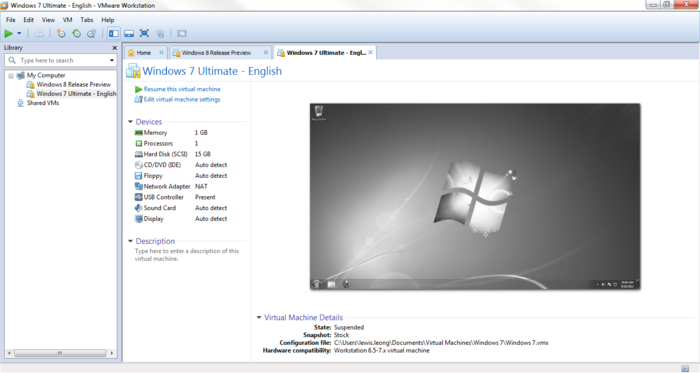

Vmware vs virtualbox windows games windows 10#
We'll be installing Windows 10 on KVM with GPU passthrough for gaming. I'll specifically be talking about GPU passthrough. This provides a near bare-metal connection, meaning there will be minimal latency. PCI passthrough gives your virtual machine direct access to a PCI slot. The guide applies to anyone who needs to use their GPU on a VM, but this is most commonly appealing to gamers. It can utilize your GPU via PCI passthrough technology. This guide will talk about gaming on a virtual machine called KVM. Even Roblox or Minecraft can be a challenge. Virtual machines on Windows OS such as VirtualBox can only utilize your CPU for graphics meaning you can't play your high end games.

You need a graphics card to play high end games such as Call of Duty Modern Warfare. I’m leaning towards VMware Workstation.Virtual machine gaming through VirtualBox and VMWare have shown to be difficult. I think I prefer Type 2 since it means the Host OS is not running in a VM! – PRO: A mid-2019 benchmark (()) of I/O performance and other common development tasks, using Bench.sh and Unixbench.sh, showed VMware winning the overall result summaries: VMware 93.11% vs Hyper-V 86.19% vs VirtualBox 66.26%. But tbh for the kinda personal work I will do, this won’t matter. – CON: A bit less efficient than Hyper-V since it’s a Type 2 hypervisor that runs on the OS level and has to translate a bunch of things to Windows API calls, which a Type 1 (Hyper-V) hypervisor would do with direct hardware access. You decide exactly what folders/disks the VM will have access to. – PRO: High performance virtual hard disks and great folder/network sharing features.

– PRO: Easy and reliable USB passthrough. Powerful enough to do work inside the VM without switching back and forth. Together with the acceleration it means I can just fullscreen the Linux VM, and do all kinds of web browsing (video decoding acceleration) and development there. – PRO: 3D acceleration for all guests and hosts (Linux and Windows). – PRO: Zero performance impact on the host system whenever the VM is off. – All other aspects of Hyper-V above apply here too. So any malware or intruders in the VM can read the host’s files. – CON: Has access to the host system’s disks. So I don’t see a major benefit compared to just having a regular shared folder that the VM can access, or drag-and-dropping files into a GUI based VM, or using a file transfer program to upload to a server running in a VM. But that still involves virtual hard disks in the actual VM, and file copy etc. – PRO: Has access to the host system’s disks. Although they’re working on an Ubuntu GUI version of it. (WSL2 which is VM-based, since WSL1 was never very compatible with things and is getting discontinued.) – CON: Only provides a terminal, no GUI. – CON: Requires Hyper-V to be active on the system.

Not sure how useful that really is though.~~ (edit: Found out VMware can autostart VMs in the background at system boot too.) – CON: I’ve seen a lot of mentions that it has longstanding issues with USB passthrough of devices. – ~~PRO: Since it sits above the OS level, it’s capable of running VMs immediately at system startup, before the user logs into the host OS. There used to be some “RemoteFX” 3D adapter thing but it was removed due to security concerns, and it only worked for Windows guests. – CON: There is no 3D acceleration for guest operating systems. Can take direct hardware shortcuts instead of having to negotiate through the Windows kernel. – PRO: The other VMs will have slightly better performance than VMware though, since the hypervisor runs with higher process priority and rights, and it’s closer to the metal. – CON: Type 1 Hypervisor (sits above the OS level): Forces the host (Windows 10) to be a virtual machine too, which causes a performance reduction in overall computer performance, especially in games.
Vmware vs virtualbox windows games full#
I’m looking into using these for some personal coding projects, and always having access to a full Linux VM with Docker for hosting things while developing etc.įrom what I can see, VMware Workstation is the best.


 0 kommentar(er)
0 kommentar(er)
